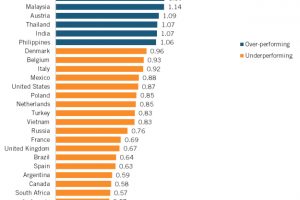Australia’s GDP report shows the economy growing by a larger-than-expected 0.9% in the September quarter on the back of surging commodities exports and strengthening household consumption.
Having had time to digest the release, analysts notes are now offering their views on how to interpret the mammoth data release.
Some have expressed cautious optimism, while others doubt the strength of the September quarter will last.
Here’s a selection of the economic notes that have hit our inbox this afternoon on Australia’s economic community.
Felicity Emmett, ANZ
The details of the release were broadly consistent with our expectations: sharply falling business investment, declining public spending, strong net exports, and moderate household consumption growth. The pickup in household consumption is encouraging, especially when combined with stronger wages growth. But it’s really too early to be confident that spending will pick up strongly, especially given that any impetus from higher house prices is likely to be fading.
While the weakness in income is likely to continue to weigh on recovery in the real economy and keep growth below trend in the near term, growth in these measures now looks to be turning up.
Overall, growth remains soft, but momentum looks to be turning. The strength in net exports is very unlikely to be repeated in Q4, especially given that it looks to be largely driven by a reversal of weakness in Q2. But taken together with the low Q2 GDP outcome, six month annualised growth is running at close to 2½% – softish, but not too far off potential. And with signs that momentum is bottoming, today’s numbers suggest that the non-mining recovery is slowly taking hold.
Michael Blythe, CBA
By far, the largest driver of growth over QIII was net exports. The 1.5ppt contribution was, in part, related to some statistical payback from a weather-impacted QII result. Notwithstanding, the big contribution from net exports is the payoff from a mining investment boom. Export volumes will continue to rise over coming years and will be a strong contributor to economic growth. Unfortunately, however, for Australian incomes, commodity prices have fallen sharply which means that the big lift in export volumes is not generating a commensurate lift in income. A lower AUD is providing some offset, but commodity prices are also materially lower in USD terms.
GDP growth, whatever way you cut it, remains below trend and is likely to remain there as long as the mining capex boom is unwinding. And national income growth remains exceptionally weak and is likely to remain there as long as commodity prices are falling.
Today’s data deserves a positive spin. But the weakness in incomes remains a concern. We have essentially lost control of the income side of the equation. The focus inevitably turns to costs. Governments want to cut spending to push the budget back towards surplus. Companies want to protect profits by deferring labour hiring and capex. Households focus on saving and balance sheet repair rather than spending.
Scott Haslem, UBS
Q3 real GDP showed a solid bounce, after Q2 slowed to near the worst since the GFC. However, the pickup was clearly boosted by a huge rebound in the contribution from net exports, which is unsustainable for Q4 (albeit the RBA now only needs 0.2% q/q GDP in Q4 to hit their 2¼% y/y forecast). Meanwhile, the domestic economy overall remains relatively weak, but is being depressed by a capex cliff (which appears likely to remain a large drag ahead); yet despite this, the moderately positive trends in consumption and housing remain intact. Nonetheless, amid a collapsing terms of trade, economy-wide ‘inflation’ & ‘real income’ are still falling. That said, looking forward, with RBA Governor Stevens saying Q3 GDP was ‘not a bad outcome’ and ‘just a little below trend’, we continue to expect the RBA to hold rates in 2016.
Shane Oliver, AMP Capital
The rebound in September quarter GDP growth is good news and indicates that the economy is continuing to rebalance and find sources of growth to offset the slump in mining investment and the blow to national income from collapsing export prices. We are now three or four years into the end of the mining boom and yet the recession that many said was inevitable has not happened.
However, while recession has been avoided and this is likely to remain the case it’s important to recognise that the September quarter growth rebound is not likely to be repeated. The huge rise in export volumes is partly a correction to a sharp fall seen in the June quarter and likewise import volumes are unlikely to keep falling at the rate seen last quarter. A better guide to growth is to average the last two quarters and this suggests that growth is currently running around 0.6% quarter on quarter or 2.4% annualised.
The strong net export contribution masks continuing very weak demand in the economy. The risk for next year is that with mining investment still falling , demand could slow further as the contribution to growth from dwelling investment and wealth gains from rising home prices fades and as further bank mortgage rate hikes in response to increasing capital requirements cut into household spending power.
Against this backdrop our assessment remains that the economy is likely to need more help from monetary easing next year, both from a lower Australian dollar and a further cut in interest rates by the RBA. So while the RBA is likely to be happy with the September quarter growth numbers, it’s likely to come under pressure (yet again) to ease further next year.
Paul Bloxham, HSBC Australia
Today’s GDP numbers show an economy that is doing well, considering the circumstances. Australia is in its 25th year of continuous growth, which is the longest period expansion in the country’s history. Growth picked up in Q3, following only weak growth in Q2, despite two significant headwinds. First, the terms of trade once again declined, falling by a sharp 10.5% YoY, driven by lower commodity prices. Second, mining investment fell significantly, dragging overall business investment down by a steep 11.0% YoY. Business investment subtracted 1.8ppts from GDP over the past year, which is the largest drag from business investment in the history of the quarterly GDP numbers (since 1960).
Although real GDP is growing, it is still running below its trend pace, in part reflecting that the fall in commodity prices is weighing heavily on domestic incomes. Renewed declines in commodity prices in recent weeks and a rising Australian dollar may put further pressure on domestic income growth in coming months.
The challenge the RBA faces is that, although growth is lifting and is quite solid, it is still running at a below-trend pace and thus not likely to drive a lift in inflation unless it picks up further.
This post was originally published in BusinessInsider




